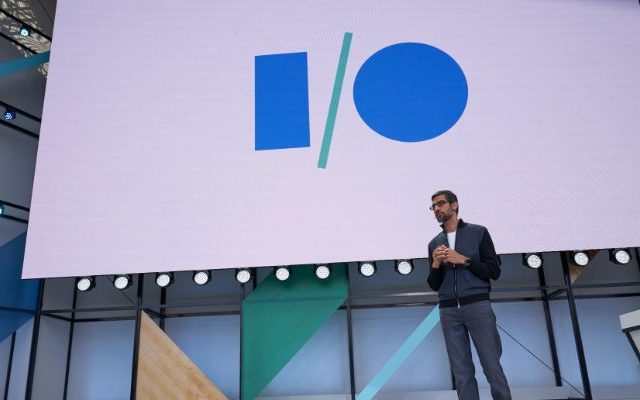Looks like Google I/O, their annual developer conference is now likely to stay in their backyard at Shoreline Amphitheatre as opposed to Moscone center in San Francisco where eight of their previous conferences were held.
Shoreline Amphitheatre is an open-air venue in the pacific coast of California with abundant sunshine, and Google’s CEO Sundar Pichai opened the keynote by urging the 7000+ members present to apply the sunscreen liberally and declared “it’s on us”.
The #io17 keynote was a two-part series and long enough that we had a lunch break in between; there was a whole bunch of announcements made to please two types of people who matter to Google the most – Developers & Consumers.
Gone are the tactics of skydiving Glass wearers and giving away of a bounty of laptops and smartphones to attendees. After 18 years since inception, Google has now sobered up and it is a bit boring when I realized they are losing their child-like enthusiasm.
Nevertheless, they have aged well, and this year’s IO clearly focused on driving home one message ‘Mobile first world to AI first world’. Here’s how they did it.
Bragging and show of strength: While Android has crossed two billion users, six other Google products enjoy a billion plus users every month, they are Search, Gmail, Chrome, YouTube, Maps, and Play Store. CEO Sundar Pichai and his clique proudly demonstrated how machine learning and AI are being integrated into their products for transitioning from a mobile first world to a AI first world. Gmail gets Smart Replies, something that’s borrowed from their messaging app Allo. Upcoming Android O gets Smart Text selection which automatically differentiates between a phone number and a postal address when you select a text, Android phones are now fortified with Google Play Protect, which uses machine learning to scan one billion devices and 50 billion apps each day to protect its users from malware and it even helps in finding lost phones.
Mr. Pichai also emphasized how voice and image has become an important mode of computing and even showed off a chart that claims their algorithm has lower error rate than humans in terms of image recognition. This was quickly followed by announcement of Google Lens for Assistant, which essentially uses smartphone camera as an input device and reduces the need to search through typing text or giving voice commands.
Each of the above is made possible by deploying Machine learning & AI at scale through their advanced TPU deployed on Google cloud. TPU or tensor processing units are much faster & powerful than normal CPU & GPU, by deploying them on cloud and making it accessible for everyone, Google thinks every developer can build next generation products. Collectively they call this as ‘Google.ai’ which is an ensemble of tools, efforts and research that aims to bring the benefits of AI to everyone.
Some of the applied AI areas from Google.AI transcends way beyond just making Google products smarter. From DNA sequencing to helping pathologist diagnose cancer better, Google.AI is on a poignant journey to make the world be a better place.
With such profound application of technology, the atmosphere around the keynote hit a crescendo of drama but Sundar swiftly brought the geeky mood back by showing a light-hearted application called AutoDraw which uses applied AI to convert our scribbles of a cat into an actual cat drawing.
Digital inclusion: Not to be confused with reaching & including people at grassroots level, here we are talking about Google being inclusive of first world citizens & Apple fans. The most compelling use case of AI to make an average users’ life better is through Google Assistant; the chatty, natural language assistant that aims to help us in real world was launched in during io16 for Google Home and subsequently introduced for Pixel phones, it is now available for iPhone. On both Android and iPhone, Google Assistant will now work in French, German, Brazilian Portuguese and Japanese. And coming soon are Italian, Spanish and Korean
But that’s not all, Google just opened the Assistant SDK for developers & OEM of any apps and electronic appliances to be Google Assistant compatible. They have already worked with leading consumer appliances brand including LG, Bang & Olufsen, Sony among others and these products are hitting the shelf soon. With this, you can ask your smartphone to turn the a/c on or play music in home audio system.
Besides Assistant coming to iPhone, Daydream VR is coming to headsets from partners including HTC and Lenovo which won’t require a smartphone or PC to power the user’s VR experience. Users just put the headsets on and it works. They work on a principle Google calls as ‘WorldSense’ which is powered by technology from its Tango AR system.
Attracting the next billion users: India alone added over 100 million people online last year, this is the highest growth among any country in the world. Google tried to woo Indians with Android One, a bunch of low cost devices launched during 2015 but they dint do very well. Google is now taking off from exactly where they left off from Android One, this time with a strategy that stems from software, an OS called Android Go, and not through price controls through affordable or cheap hardware /smartphones.
Google announced Android Go at this IO, a modified OS spinoff from its latest Android O. Android Go is poised to work on cheap smartphones with less than 512MB of RAM and comprises a rebuilt set of Google apps such as YouTube Go, a new leaner version of Google Play Store and more.
It is interesting and amusing to see how Google promotes both web and apps, two opposing tech philosophies in same measure. While Android GO helps in delivering leaner apps, Progressive Web Apps and Accelerated Mobile Page (PWA & AMP respectively) helps have better web experiences even in 2G connections and slower devices.
While io16 saw Flipkart lite demo their PWA site that even works offline, this year we saw representatives of Ola cabs on stage who booked a cab using PWA which uses just 0.5MB of data on a web browser and requires no app download, as opposed to a 100MB of space Ola app occupies on IOS or 60MB on Android.
Sundar Pichai also briefly mentioned about how Google Translate is now using neural machine translation technology to translate between English and nine widely used Indian languages in a more accurate way.
Beside the keynote, there were dedicated sessions and talks to win in India where internet based products can’t expect continuous internet connectivity!
Strengthening their ad business: by knowing their consumers well. Nearly 90% of Google’s revenue till date comes from advertising revenues, they are the world’s leading media company and second comes Facebook. Facebook has its social graph which plainly knows what places, brands, events and people their consumers ‘likes’ and who are they related to and how they feel about a give topic. Armed with this information they can show more relevant ads that delivers better ROI for their paying customers. Google lacks such a social graph until now.
Microsoft acquired LinkedIn and the benefits of knowing how people are connected and behave in a professional context will lead to a huge accrual of insights for a company creating and selling productivity products. Understanding connections and relations between people is where Google has a chink the armor and they are fixing it in an amazing way with Google Photos and Home, both products work in a way that connects individual users to their friends and family, let’s Google learn about ‘us’ than just know about me basis what I searched or browsed.
Google photos has over 500 million users who upload billion of pictures every day, this IO they launched a feature called ‘Suggested Sharing’ which nudges a user to share pictures with friends or family who’s in the picture captured by the user. Another feature announced is the ’Shared Libraries’ which can automatically send and receive relevant photos between two contacts. Now imagine the possibilities of creating a contextual understanding of each of its users as a connection to another user.
There it is, Google photo is Google’s own social graph; and they are taking this so seriously that have launched a physical photo book printing service called ‘Photo Books’ in US. It starts at $9.99 and all the IO attendees get a photo book for free. Sure, why not start with the developer community to test the new social graph.
Though Google doesn’t talk about its enterprise and business solutions such as AdWords or Analytics in IO, it does a follow up event called Marketing Next where new updates and product features that matter to advertisers are announced.
Everything else: Everything else we saw was not new bets like Allo or Duo that took on the competition like last year, but a bunch of innovations that’d keep Google on top of the game they are already good at. YouTube supports 360-degree video on connected TVs, content creators and artistes get additional means to generate revenue through Super Chat, a feature where fans can pay for their comment to be pinned and highlighted during a live performance on YouTube.
The developer community in the amphitheater cheered with an intensity that would shame soccer hooligans when Kotlin, a new age programming language, was declared as officially supported for Android!
With Daydream, Google is pushing the boundaries of VR. Not only are they taking the smartphone out of the VR headsets but they’re also making it more useful than for just entertainment and games. A new navigational concept called VPS or Virtual Positioning Service was announced, it’s an advanced VR based navigation that accurately works in indoor spaces. In the demo video, we saw how VPS can help you find the right tool in the right aisle in a massive shopping store.
As a conclusion when Sundar Pichai came back to stage, he announced the biggest incremental feature that Google Search has ever got – Google for Jobs. Google’s take on simplifying the job search for both blue and white collars across skills and experience. They are doing this in collaboration with LinkedIn, Facebook, Monster among others and of course it uses Machine learning to make the job hunt easy for users.
Google has realized the shift from mobile to AI, it is not only reimagining each of its product to stay ahead of the curve but is also urging developers to join the journey. The restraint displayed in not launching any more me too products as challengers unlike previous years says volumes about a matured leadership. Every new feature or innovation they are working on ultimately leading to better advertising solution and thus increased revenue is a masterclass in business strategy; something that many new age, cash-burning startups can learn from.
After all, the greatest innovation happens through collaboration and we see that in plenty at a developer conference aptly namds IO which stands for ‘innovation in the open’.
Article by channel:
Everything you need to know about Digital Transformation
The best articles, news and events direct to your inbox
Read more articles tagged: AI, Featured, Machine Learning, Mobile, Virtual Reality







